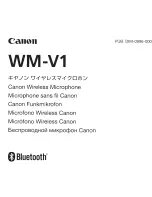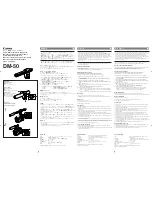
4
cases when not in use. With proper maintenance, the microphone and preamplifier should provide stable
and accurate results for years to come.
Dust, rain, oil, moisture or exposure to extreme temperatures may adversely affect the microphone and
preamplifier’s performance. If the microphone or the inside of the connection area of the preamplifier be-
comes contaminated, use a light pressure rubber bulb to gently blow clean, dry air onto the unit in order to
remove the dust. In the event that you absolutely must take off the grid cap and clean the microphone dia-
phragm, we recommend using a blow bulb or a light pressure, clean and dry air hose to gently blow con-
tamination off the diaphragm. The direction of the air should be parallel with the diaphragm, not directly
(0 degree incidence) pointed at the diaphragm. Do not touch the microphone’s diaphragm with your fin-
gers or let it come in contact with any sharp or pointed object. Please note that any contact to the micro-
phone’s diaphragm can negatively impact the sensitivity and long term stability of the microphone.
If the microphone is ever dropped or comes into contact with any contamination, or is exposed to extreme
temperatures, we recommend immediate recalibration of the microphone. Please note that heat from your
hands can affect the calibration results. It is always good practice to wait a minimum of 30 seconds after
placing the microphone on a test system before taking a calibration reading in order to minimize the effect
that heat from your hands has on the calibration.
7.0
Calibration
PCB offers recalibration services for our precision microphones, as well as units produced by other A2LA
manufacturers. Our internal metrology laboratory is certified to ISO 9001, accredited by A2LA to AN-
SI/IEC 17025 and ANSI/NCSL Z540-1, complies with ISO 10012-1 (and former MIL-STD-45662A), and
uses equipment directly traceable to one or more of the following National Labs (NIST, PTB or DFM).
Our investment in equipment, traceability and conformance to industry standards ensures accurate calibra-
tion against relevant specifications. We also carry a line of acoustic calibrators that can be used to cali-
brate microphone sensitivity on site as needed.
Hand calibration of sensitivity for most prepolarized microphones may be performed with a Larson Davis
CAL250 or CAL200 (or equivalent). The CAL250 produces 114 dB SPL at 251.2 Hz. The CAL 200
produces either 94 dB or 114 dB (user selectable) at 1000 Hz. Note that both the CAL250 and CAL 200
are compliant with ANSI S1.40-2006, Specifications and Verification Procedures for Sound Calibrators,
Class1 and IEC 60942-2003, Class 1, Sound Calibrators.
8.0
Warranty and Service
All equipment and repair services provided by PCB Piezotronics, Inc. are covered by a warranty against
defective material and workmanship under a
Total Customer Satisfaction
policy. If, at any time, for any
reason, you are not completely satisfied with any PCB product, PCB will repair, replace, or exchange it at
no charge. You may also choose to have your purchase price refunded. See the supplemental sheet, con-
tained with this manual, for information on our service, repair and return policies, procedures and instruc-
tions. When unexpected problems arise, call our 24-Hour SensorLine
SM
(716-684-0001) to speak with an
for a complete statement of our warranty.
3425 Walden Avenue, Depew, NY 14043-2495
24-hour SensorLine
SM
: 716-684-0001
E-Mail:
U.S.A. Fax: 716-684-0987
Website:
Toll-free (in the U.S.A.): 800-828-8840
A PCB GROUP COMPANY
ISO 9001 CERTIFIED
A2LA ACCREDITED to ISO 17025
2014 PCB Group, Inc. In the interest of constant product improvement, specifications are subject to change without notice.
PCB and ICP are registered trademarks of PCB Group, Inc. Sensor Line is a service mark of PCB Group, Inc. All other trade-
marks are properties of the respective owners.
Manual Number: 27042
Manual Revision: D
ECO 45294
Printed in the U.S.A.




























